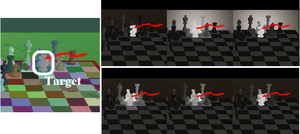Information
- Publication Type: Journal Paper with Conference Talk
- Workgroup(s)/Project(s):
- Date: August 2014
- Journal: ACM Transactions on Applied Perception (Special Issue SAP 2014)
- Volume: 11
- Number: 3
- Location: Vancouver, Canada
- Lecturer: Matthias Bernhard
- ISSN: 1544-3558
- Event: ACM Symposium on Applied Perception (SAP 2014)
- Conference date: 8. August 2014 – 9. August 2014
- Pages: 14:1 – 14:17
- Keywords: object-based attention, eye-tracking, virtual environments, visual attention
Abstract
Stimuli obtained from highly dynamic 3D virtual environments and synchronous eye-tracking data are commonly used by algorithms that strive to correlate gaze to scene objects, a process referred to as Gaze-To-Object Mapping (GTOM). We propose to address this problem with a probabilistic approach using Bayesian inference. The desired result of the inference is a predicted probability density function (PDF) specifying for each object in the scene a probability to be attended by the user. To evaluate the quality of a predicted attention PDF, we present a methodology to assess the information value (i.e., likelihood) in the predictions of dierent approaches that can be used to infer object attention. To this end, we propose an experiment based on a visual search task which allows us to determine the object of attention at a certain point in time under controlled conditions. We perform this experiment with a wide range of static and dynamic visual scenes to obtain a ground-truth evaluation data set, allowing us to assess GTOM techniques in a set of 30 particularly challenging cases.Additional Files and Images
Weblinks
BibTeX
@article{bernhard-2014-GTOM,
title = "Gaze-To-Object Mapping During Visual Search in 3D Virtual
Environments ",
author = "Matthias Bernhard and Efstathios Stavrakis and Michael
Hecher and Michael Wimmer",
year = "2014",
abstract = "Stimuli obtained from highly dynamic 3D virtual environments
and synchronous eye-tracking data are commonly used by
algorithms that strive to correlate gaze to scene objects, a
process referred to as Gaze-To-Object Mapping (GTOM). We
propose to address this problem with a probabilistic
approach using Bayesian inference. The desired result of the
inference is a predicted probability density function (PDF)
specifying for each object in the scene a probability to be
attended by the user. To evaluate the quality of a predicted
attention PDF, we present a methodology to assess the
information value (i.e., likelihood) in the predictions of
dierent approaches that can be used to infer object
attention. To this end, we propose an experiment based on a
visual search task which allows us to determine the object
of attention at a certain point in time under controlled
conditions. We perform this experiment with a wide range of
static and dynamic visual scenes to obtain a ground-truth
evaluation data set, allowing us to assess GTOM techniques
in a set of 30 particularly challenging cases.",
month = aug,
journal = "ACM Transactions on Applied Perception (Special Issue SAP
2014)",
volume = "11",
number = "3",
issn = "1544-3558",
pages = "14:1--14:17",
keywords = "object-based attention, eye-tracking, virtual environments,
visual attention",
URL = "https://www.cg.tuwien.ac.at/research/publications/2014/bernhard-2014-GTOM/",
}


 draft
draft video
video

